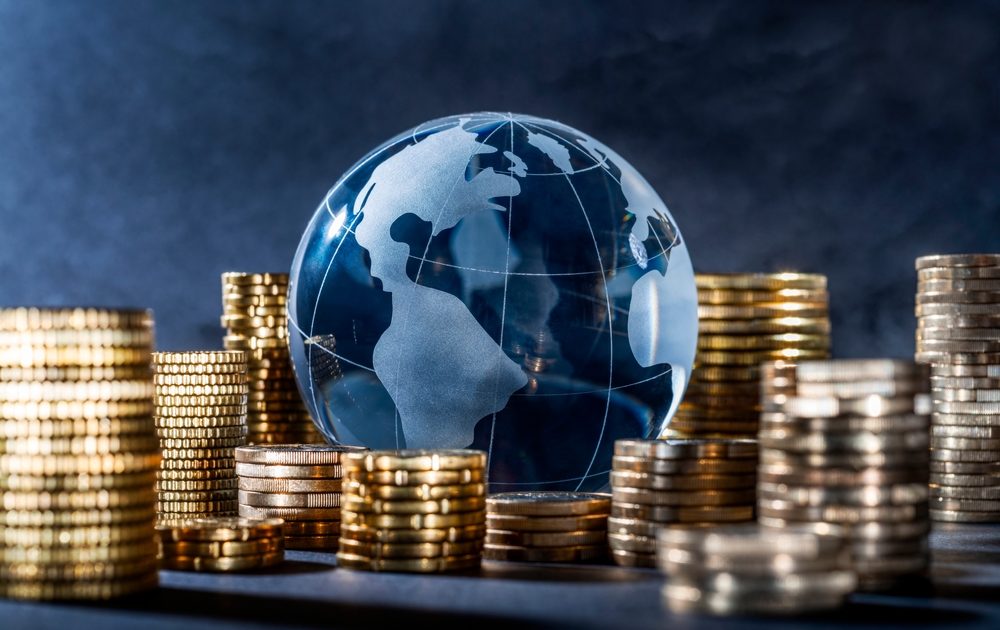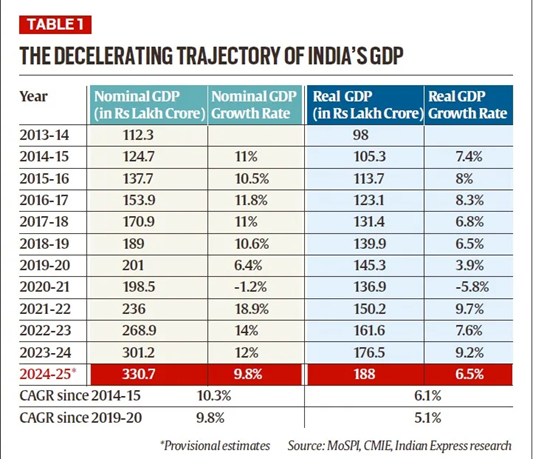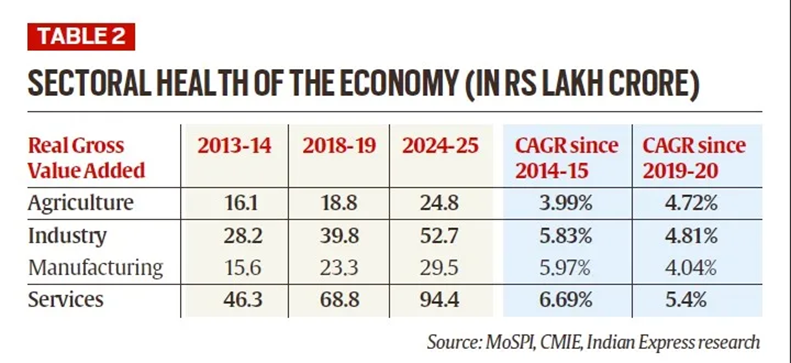- Courses
- GS Full Course 1 Year
- GS Full Course 2 Year
- GS Full Course 3 Year
- GS Full Course Till Selection
- Essay Target – 150+ Marks
- Online Program
- GS Recorded Course
- NCERT (Recorded 500+ Hours)
- Polity Recorded Course
- Geography Recorded Course
- Economy Recorded Course
- AMAC Recorded Course
- Modern India, Post Independence & World History
- Environment Recoded Course
- Governance Recoded Course
- Science & Tech. Recoded Course
- International Relations and Internal Security Recorded Course
- Disaster Management Module Course
- Ethics Recoded Course
- Current Affairs Recoded Course
- CSAT
- 5 LAYERED ARJUNA Mentorship
- Public Administration Optional
- ABOUT US
- OUR TOPPERS
- TEST SERIES
- FREE STUDY MATERIAL
- VIDEOS
- CONTACT US
India’s Provisional GDP Estimates for FY25
India’s Provisional GDP Estimates for FY25

- In May 2025, the National Statistics Office (NSO) under Ministry of Statistics and Programme Implementation (MoSPI) released:
- Q4 FY25 (Jan-Mar 2025) economic growth data.
- Provisional estimates for FY25 GDP growth.
- These estimates provide insight into the size and growth of India’s economy for 2024-25.
- Overall Economic Performance (FY25)
- Headline Growth (FY25): India's real GDP grew by 6.5% in FY25, which is the slowest growth rate since the pandemic year 2020-21.
- Q4 FY25 Performance:
- Real GDP growth accelerated to 7.4% in Q4 FY25, marking the fastest quarterly growth within FY25.
- However, Q4 FY25 growth (7.4%) is higher than Q3 FY25 (6.4%) but slower than Q4 FY24 (8.4%) of the previous financial year (2023-24)
- Q4 performance pushed full-year GDP growth to 6.5%.
Measurement of National Income :
|
Term |
Definition |
Perspective |
|
Gross Domestic Product (GDP) |
OR
|
Demand-side |
|
Gross Value Added (GVA) |
Value added at each production stage by various sectors; sum of incomes from production. |
Supply-side |
- Relationship: GDP = (GVA) + (taxes earned by government) — (subsidies provided by government)
- Data provided in nominal (current prices) and real terms (inflation-adjusted).
Why Are Estimates “Provisional”?
- GDP estimates are released in stages with increasing data accuracy:
- Jan: First Advance Estimates (FAEs)
- End-Feb: Second Advance Estimates (SAEs) (includes Q3 data)
- May: Provisional Estimates (PEs) (includes Q4 data)
- Next 2 years: First Revised Estimates (1 year later), Final Estimates (2 years later)
- Each revision refines accuracy based on more comprehensive data.
Key Economic Data (FY25)

a) Nominal GDP (at current prices)
- Size: ₹330.7 trillion (₹33.07 lakh crore)
- Growth over FY24: 9.8%
- Dollar equivalent (₹85.559/USD): $3.87 trillion
- Significance:
- 3rd slowest nominal GDP growth since 2014
- 6th slowest since 1991 economic liberalisation
- CAGR since 2014-15: 10.3%
- CAGR since 2019 (NDA 2.0): 9.8% (slowing trend)
b) Real GDP (inflation-adjusted)
- Size: ₹188 trillion
- Growth: 6.5% (vs. 9.2% in FY24) — sharp deceleration
- CAGR since 2019: ~5% (low compared to previous decade)
- Real GDP reflects actual increase in goods and services, removing the inflation effect.
Chief Economic Advisor V. Anantha Nageswaran said :
- India’s post-COVID slowdown is “growth-scarce” environment resilient.
- Growth differential between India and advanced economies is higher post-COVID than during the 2003-2010 boom era.
- India’s economy outperforming many advanced economies amid global uncertainties like political conflicts and trade tensions.
Sectoral Performance :

Consumption and Investment :
|
Indicator |
Growth FY25 |
Growth FY24 |
Notes |
|
Private Final Consumption Expenditure (PFCE) |
7.2% |
5.6% |
Household consumption accelerated |
|
Gross Fixed Capital Formation (GFCF) |
7.1% |
8.8% |
Investment growth slowed, despite Q4 jump to 9.4% |
- PFCE growth quickened, reflecting stronger consumer demand.
- GFCF (asset creation) growth slowed overall despite a strong Q4 performance.
Manufacturing Sector: A Key Concern
- Manufacturing GVA CAGR (since 2019-20): 4.04%
- Lower than Agriculture & Allied (4.72%)
- Implications:
- High urban youth unemployment
- Reverse labor migration to rural/agriculture sectors
- Weak manufacturing growth threatens India’s economic diversification and job creation
Government efforts:
- “Make in India” (2016) — boost manufacturing for jobs and exports
Global context: Manufacturing is critical amidst US-EU-China trade tensions.
|
Term / Concept |
Definition |
Explanation / Perspective |
|
Nominal GDP |
GDP measured at current market prices, without adjusting for inflation. |
Shows the size of the economy in current prices; affected by inflation. |
|
Real GDP |
GDP adjusted for inflation; reflects actual increase in production of goods and services. |
Measures true growth by removing price changes; better for comparing growth over time and across countries. |
|
GDP Growth Rate |
Percentage increase in GDP compared to previous period (usually year-on-year). |
Indicates how fast the economy is expanding or contracting. |
|
Compound Annual Growth Rate (CAGR) |
Average annual growth rate over multiple years, assuming compounding. |
Shows long-term growth trend, smoothing short-term fluctuations. |
|
Provisional Estimates (PEs) |
Initial GDP estimates for a financial year released after the year ends, subject to revision. |
Based on data available till end of Q4; revised later for accuracy. |
|
First Advance Estimates (FAEs) |
Preliminary GDP estimates released mid-year, based on partial data. |
Early indication of economic performance, less accurate. |
|
Second Advance Estimates (SAEs) |
Updated estimates including more complete data, usually after Q3. |
Improves accuracy over FAEs but still provisional. |
|
Taxes and Subsidies (in GDP) |
Taxes on products add to GDP, subsidies reduce GDP. |
GDP = GVA + Taxes − Subsidies; this adjusts supply-side value to demand-side GDP measure. |
|
Private Final Consumption Expenditure (PFCE) |
Total value of goods and services consumed by households. |
A key driver of GDP; shows consumer demand and spending power. |
|
Gross Fixed Capital Formation (GFCF) |
Total investment in fixed assets (machinery, buildings, infrastructure). |
Indicates investment trends; vital for future productive capacity and economic growth. |
|
Sectoral Growth (Agriculture, Manufacturing, Services, Construction) |
Growth rates of different sectors contributing to GDP. |
Shows which parts of the economy are driving or slowing growth. |
|
Supply Side vs Demand Side |
Supply side focuses on production/output (GVA); demand side on spending/expenditure (GDP). |
Two ways to measure economic activity; ideally both match in total value. |
|
Growth Differential |
Difference in growth rates between two economies or periods. |
Used to compare India’s growth against advanced economies or previous eras. |
|
Inflation Adjustment |
Process of removing the effect of rising prices from economic data. |
Allows comparison of real output or growth, not distorted by price changes. |




